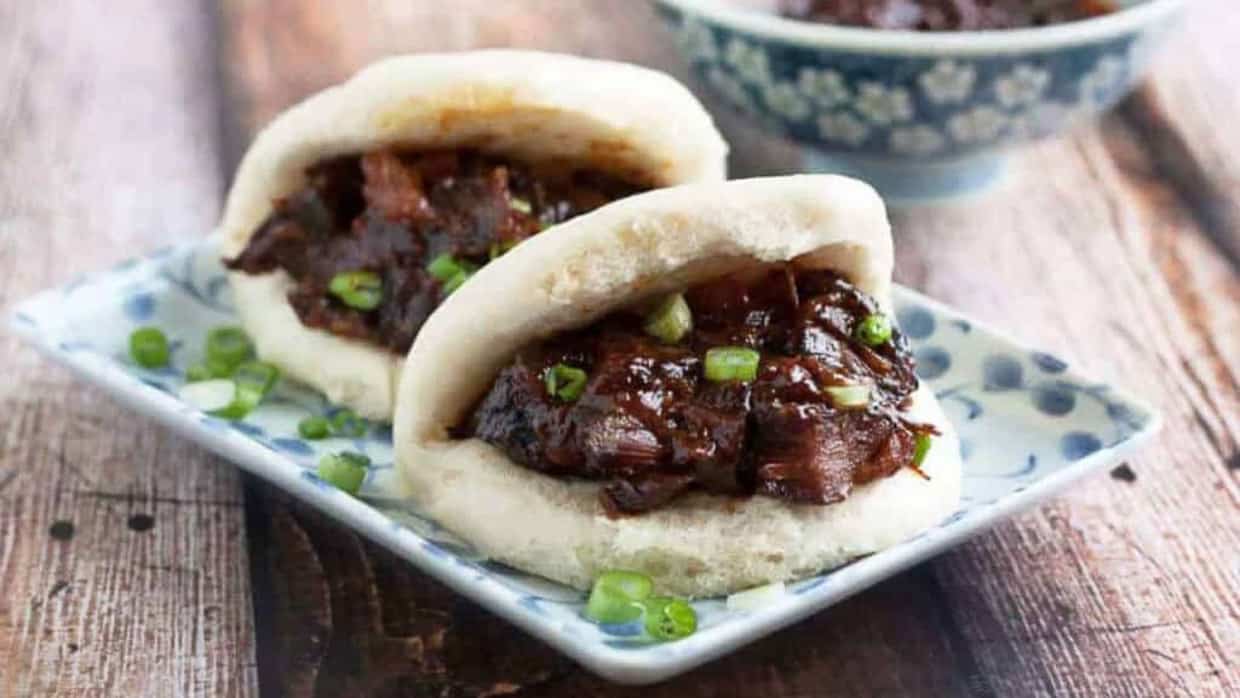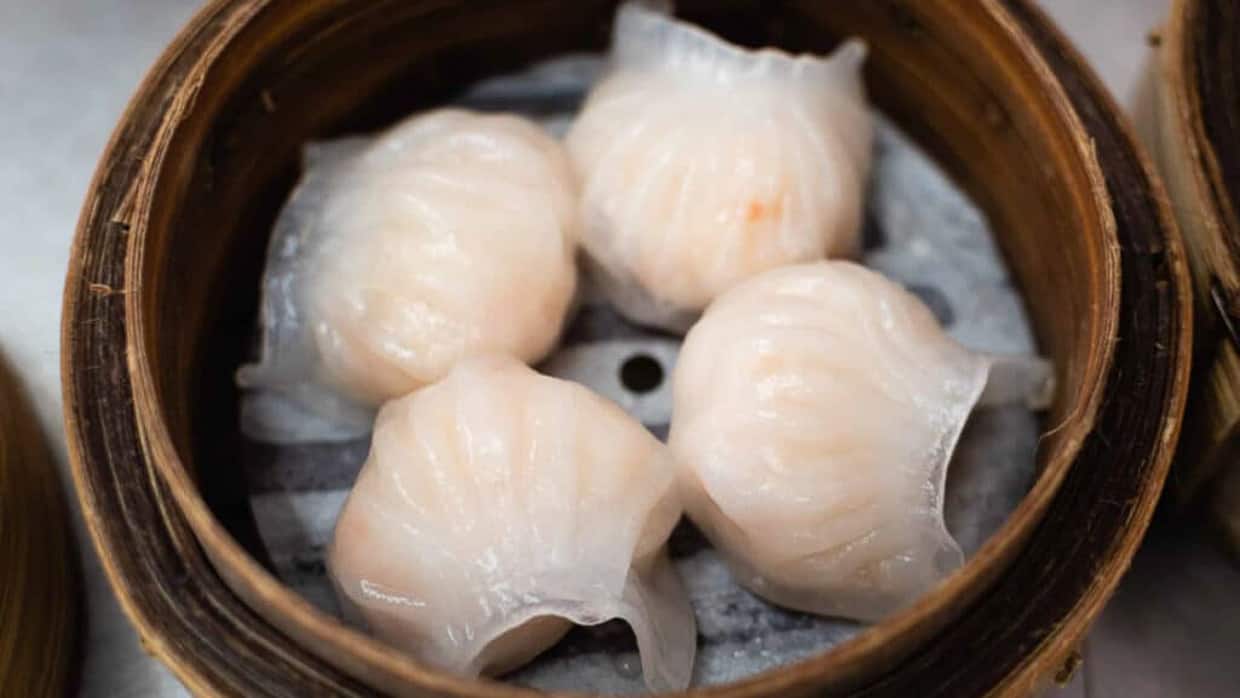“Dim sum” translates to a little bit of heart and refers to the Cantonese cuisine of small, bite-sized dishes enjoyed as a light meal or snack with tea. The dishes are usually deep fried, steamed, or baked, providing a wide variety of textures and flavors. These small bites are meticulously crafted and packed with big, intense flavors.

Dating back to the 10th century on Canton’s famous Silk Road, dim sum originated in roadside tea houses that catered to weary travelers and rural farmers. When only offering tea seemed insufficient, tea house proprietors started offering their customers small snacks, too, and the art of dim sum was born.
Today there are more than 2,000 varieties of dim sum — from pillowy buns stuffed with tender barbecued pork to delicate dumpling wrappers filled with juicy shrimp to lettuce cups folded around spicy minced squab. And you’ll find Chinese dim sum restaurants all over the world and across the U.S., from San Francisco Chinatown to New York City.
Many dim sum restaurants don’t have printed menus. Instead, servers push rolling carts laden with plates and steamer baskets around the dining room for diners to pick and choose from. Feel free to ask if you’re unsure what a particular dish is. At the end of the meal, a server tallies your plates to determine the amount of your bill.
Traditionally served from first thing in the morning into the early afternoon, some believe the cuisine inspired the Western concept of brunch. And, really, what could be better on a lazy Sunday morning than a never-ending stream of tantalizing treats wheeled by your table where you can pick and choose among them with simple points and nods?
“Dim sum is one of my favorites because — like tapas — it lets me try all the things. I have a few favorites I have to order every time, like char siu bao (steamed pork buns), cheung fun with char siu (rice noodle crepes with bbq pork), lo mai gai (sticky rice wrapped in lotus leaves), and of course nai wong bao (egg yolk custard in steamed buns) for dessert. If it’s a restaurant with xiao long bao (soup dumplings), I may get a double order because they are hands down my favorite.”
— Michelle Price, Honest and Truly

Anatomy of a dim sum meal: The offerings
A typical dim sum meal is an adventure, offering a wide array of delicacies. Your server will most certainly offer to start you off with a pot of hot tea, and from there, you can choose your dishes off of carts if the restaurant has them or mark your choices on a printed form. Here’s a glimpse into the various components that make up a traditional dim sum spread.
Filled with appetizers, salads, sides, mains and desserts, Food Drink Life's cookbook will become your favorite!
- Easy and delicious recipes from a variety of top chefs and recipe developers.
- Bright, colorful pictures on every page.
- Printer-friendly recipes that you can download instantly to your device.
- Printable shopping list and a kitchen conversion sheet.
Steamed dim sum
Dumplings with either yeasted bread or noodle-like wrappers are cooked by steaming in bamboo baskets.
- Steamed bao: These steamed, fluffy buns are made from white flour and loaded with savory fillings. The most popular is BBQ pork or “char siu” bao but you’ll also find bao filled with chicken curry or mushrooms and other vegetables, too.
- “Siu mai”: These juicy and flavorful meat-and-shrimp dumplings are a dim sum classic, usually garnished with fish roe. Pork makes up the traditional filling, but you sometimes see chicken siu mai, too.
- Shrimp dumplings: Delicate and translucent, “har gow” are shrimp dumplings diners love for their thin and chewy wrappers. Variations include chives, pea shoots or cilantro in the shrimp filling.
- Soup dumplings: “Xiao long bao” have a wheat-flour-based wrapper. They’re purse-shaped dumplings filled with meat and broth and then steamed. They’re called soup dumplings they are filled with soup. They can be tricky to eat as the first bite releases a gush of the flavorful liquid. It’s an art worth practicing.
- Sticky rice in lotus leaf: “Lo mai gai” is made up of glutinous rice studded with tender pieces of chicken, meaty shiitake mushrooms, Chinese sausage (lap cheong), pork belly, dried shrimp and salted egg yolk. This mixture is wrapped in a lotus leaf and steamed.
Fried dim sum
Many dim sum dishes are deep fried to crispy, crunchy perfection.
- Fried Wontons: Wheat-flour wrappers with a seasoned ground meat filling deep fried until golden brown and crisp.
- Shrimp toast: A flavorful mixture of seasoned minced shrimp is turned into a paste, spread onto thin slices of bread and then deep fried.
- Taro dumplings: “Wu gok” consists of mashed taro root formed around a filling of ground pork, dried shrimp and mushrooms and then deep fried.
- Foil-wrapped chicken: Chunks of juicy dark-meat chicken in a sweet-savory soy glaze, wrapped in foil and deep fried. The result is the most succulent, flavorful chicken you’ve ever tasted.
- Sesame Balls: These delightful fried sweet dumplings start with a batter of glutinous rice flour with a filling of sweet red bean paste or lotus seed paste. They are deep fried to a crisp golden brown with a coating of toasty sesame seeds.
Baked dim sum
Baked dim sum includes baked versions of bao and sweet desserts, too.
- Baked bao: Like their steamed counterparts, these buns start with a fluffy white-flour dough stuffed with savory fillings like char siu or BBQ pork. Before baking, these are glazed with a sweet sugar syrup or a touch of honey that gives the golden brown buns a shimmery coating.
- Egg tarts: “Dan tat” are single-serving tartlets with a buttery pastry crust and creamy egg custard filling. They provide a delightfully sweet end to a savory meal.

“Dim sum is rare where I live, so it’s become something I love to seek out when I travel. I adore the tapas-style small dishes, and especially the soup dumplings. One thing is guaranteed: I’ll be stuffed enough to hold me over until my next trip.”
— Susannah Brinkley Henry, Feast + West
Why dim sum will touch your heart
Dim sum is not just about the food, it’s also about the communal spirit and lively atmosphere accompanying the meal. Gathering around a table filled with bamboo steamers and small plates, friends and family engage in conversation, laughter and the joy of sharing good food.
Here are a few reasons why dim sum is the ultimate social dining experience:
- Variety and exploration: Dim sum offers a vast assortment of dishes, allowing everyone to try a little bit of everything and discover new flavors together.
- Interactive dining: From pouring tea for others — a traditional gesture of politeness — to passing dishes around the table, dim sum encourages interaction and connection.
- Festive occasions: Dim sum is a popular choice for celebrations such as birthdays, Chinese New Year, or family gatherings, bringing people closer and fostering a sense of togetherness.
One more thing
Dim sum is more than just a style of cooking or eating. It’s an invitation to take time out, relax and indulge your senses. Explore the vast array of bite-sized treasures, flavors and textures while enjoying a leisurely meal with people you care about. Dim sum is the kind of thing that makes life worth savoring.
Robin Donovan is the author of more than 40 cookbooks, including the bestselling Campfire Cuisine, Ramen Obsession, and Ramen for Beginners. A food writer, recipe developer, and food photographer, she is the creator of the food blog All Ways Delicious, where she shares easy recipes for the best dishes from around the world.
